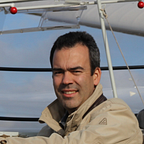How to Create Spectacular Multishot Photos
A photo series shown in one picture — how do you do that?
The process naturally starts at making the photos. It is very important that the lighting of all the photos is exactly the same, so set the camera to manual lighting with fixed shutter speed and aperture. But also set the white balance to a manual value and set the autofocus to manual. When using automatic modes all photos may have small differences in lighting, white balance or focus, what makes post-processing a lot harder. The best weather for making these photos is sunny or overcast cloudy — in other words, an even sky texture. Moving cumulus clouds may make post-processing harder because the clouds move and change shape during the photo series, or lighting conditions may change because of the cloud shades.
The camera should be on a tripod so all photos are taken in the exact same direction. For the pictures with this introduction (the red-and-yellow glider) I used the time-lapse mode of the camera. The camera took a photo every second. After starting the camera I made my flight in front of the camera. You don’t even need help from anyone to take the pictures! For the picture of the winch start I used the burst-mode of the camera with three photos/second. If possible use a remote control for the camera, if you have to press the shutter button manually you probably move your camera around a tiny bit affecting the result.
Post-processing has been done with Adobe Photoshop, but any editing program that can work with layers and masks should be able to do the trick.
With the function File > Scripts > Load Files Into Stack I import all photos to be used into one composition file. Every photo gets its own layer. Choose which photo you want to use for the background, that should be your base layer. The rest of the photos should be stacked on top of the base layer in time order.
All layers except the base layer get a mask that will show only the model in that layer. The quickmask function is a very handy tool to make quick selections of the airplane in a layer. Use a brush with soft edges to ‘paint’ a selection around the model, then invert the selection and convert the selection to a mask. Because of the soft edges on the brush you will hardly see any selection edges in the end result. You need to do this for every layer. Once you get the trick it can be done really quickly.
It may take you a few attempts to get a good photo series on camera, but it’s fun to have a goal while flying and it can actually even improve your flying skills. Your efforts will be rewarded with a stunning composite picture that will surely impress your fellow flyers.
If you have any questions, please feel free to leave them in the Responses section below and I’ll do my best to answer them. Also, if you give it a try, I would love to see the results of your efforts.
©2022 Raymond Esveldt
Read the next article in this issue, return to the previous article in this issue or go to the table of contents. A PDF version of this article, or the entire issue, is available upon request.
